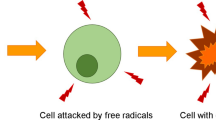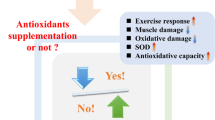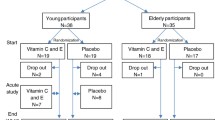Abstract
The theoretical benefits of using antioxidant vitamin supplements to quench oxygen free radicals appear large. The major function of vitamin E is to work as a chain-breaking antioxidant in a fat soluble environment so as to protect polyunsaturated fatty acids within membrane phospholipids and in plasma lipoproteins. The purpose of this critical review was to determine whether vitamin E supplementation decreases exercise-induced lipid peroxidation in humans. If vitamin E alone is ineffective, researchers can turn their efforts to other individual antioxidants or combinations. Using the search words “vitamin E”, “exercise”, “lipid peroxidation” and “antioxidant”, all relevant studies since 1985 were identified through a computer search using Pub Med and Sport Discuss databases. Additional articles were reviewed from the reference list of the retrieved articles. Nine vitamin E studies met the criteria of using human participants in an experimental design. Studies were analyzed to determine the strength of evidence regarding the efficacy of vitamin E supplementation. Strength of evidence was based on: (1) number of participants, (2) intensity of the exercise test, (3) type of research design, (4) other controls, (5) the biomarker of lipid peroxidation, (6) the timing of the biomarker measurement, (7) measurement of vitamin E status and (8) correction for plasma volume change. Overall, the six studies showing no effect of vitamin E supplementation had a much higher total score (67) in comparison to the three studies showing positive effects (38). Although limitations have plagued much of the research, vitamin E supplementation does not appear to decrease exercise-induced lipid peroxidation in humans.
Similar content being viewed by others
References
Allesio H (1993) Exercise-induced oxidative stress. Med Sci Sports Exerc 25:218–224
Burton G, Joyce W, Ingold K (1983) Is vitamin E the only lipid-soluble, chain breaking antioxidant in human blood plasma and erythrocyte membranes? Arch Biochem Biophys 221:12114–12119
Burton GW, Ingold KU (1986) Application of the principles of physical organic chemistry to the exploration of its structure and function. Acc Chem Res 19:194–201
Dekkers J, Van Coornen L, Kemper H (1996) The role of antioxidant vitamins and enzymes in the prevention of exercise-induced muscle damage. Sports Med 3:213–238
Dragon I, Dinu V, Dristea E, Mohora N, Ploesteanu E, Stroescu V (1991) Studies regarding the effects of an antioxidant compound in top athletes. Rev Roum Physiol 28:105–108
Duthie G, Arthur J, James W (1991) Effects of smoking and vitamin E on blood antioxidant status. Am J Clin Nutr 53 [Suppl]:1061S-1063S
Eiserich J, van der Vliet A, Handelman G, Halliwell B, Cross C (1995) Dietary antioxidants and cigarette smoke-induced bio-molecular damage: a complex interaction. Am J Clin Nutr 62 [Suppl]:1490S-1500S
Esterbauer H., Striegl G, Puhl H, Rotheneder M (1989) Continuous monitoring of in vitro oxidation of human low density lipoprotein. Free Radic Res Commun 6:67–75
Frei B, Stocker R, Ames B (1988) Antioxidant defences and lipid peroxidation in human blood plasma. Proc Natl Acad Sci USA 85:9748–9752
Galeotti T, Borrello S, Masotti L (eds) (1990) Oxygen radicals: systemic events and disease processes. Thur, Basel
Halliwell B, Chirico, S. (1993) Lipid peroxidation: its mechanism, measurement and significance. Am J Clin Nutr 57 [Suppl]:715S-725S
Harris M, McMurrray R (1995) Vitamin E supplementation, delayed onset muscular soreness and lipid peroxidation. Masters Thesis, University of North Carolina, Chapel Hill
Hoshino E, Shariff R, Van Gossum A, Allard J, Pichard C, Kurian R, Jebhoy K (1990) Vitamin E suppresses increased lipid peroxidation in cigarette smokers. J Parenter Enteral Nutr 14:300–305
Institute of Medicine (2000) Dietary reference intakes for vitamin C, vitamin E, selenium and carotenoids. National Academy Press, Washington, DC
Kanter M, Nolte L, Holloszy J (1993) Effects of an antioxidant mixture on lipid peroxidation at rest and post exercise. J Appl Physiol 74:965–969
Kalra J, Chaudhary A, Prasad K (1991) Increased production of oxygen free radicals in cigarette smokers. Int J Exp Pathol 72:1–7
Lovlin R, Cottle W, Pyke I, Kavanagh M, Belcastro A (1987) Are indices of free radical damage related to exercise intensity. Eur J Appl Physiol 56:313–316
Maughan R, Donnelly A, Gleeson M, Whiting P, Walker K, Clough P (1989) Delayed onset muscle damage and lipid peroxidation in man after a downhill run. Muscle Nerve 12:332–336
Maxwell S, Jakeman P, Thomason-Leguen C, Thorpe G (1993) Changes in plasma antioxidant status during eccentric exercise and the effect on vitamin supplementation. Free Radic Res Commun 19:191–202
Meydani M, Evans J, Handelman G (1993) Protective effect of vitamin E on exercise induced oxidative damage in young and older adults. Am J Physiol 264:R992-R998
McBride J, Kraemer W, Triplett-McBride T, Sebastianelli W (1997) Effect of resistance exercise on free radical production. Med Sci Sport Exerc 30:67–72
Niki E (1997) Action of ascorbic acid as a scavenger of active and stable oxygen radicals. Nutr Cancer 15:251–252
Packer L (1984) Vitamin E, physical exercise, and tissue damage in animals. Med Biol (Helsinki) 62:105–109
Rokitzki L, Logemann E, Huber G, Keck E, Keul J (1994) α tcopherol supplementation in racing cyclists during extreme endurance training. Int J Sport Nutr 4:253–264
Sacheck JM, Milbury PE, Cannon JG, Roubenoff R, Blumberg JB (2003) Effect of vitamin E and eccentric exercise on selected biomarkers of oxidative stress in young and elderly men. Free Radic Biol Med 34:1575–1588
Seyama A (1993) The role of oxygen-derived free radicals and the effect of free radical scavengers on skeletal muscle ischemia/reperfusion injury. Surg Today 23:1060–1067
Subudhi A (1999) Free radical production and antioxidant supplementation in elite alpine ski racing. Am Ski Coach 19:14–17
Sumida S, Tanaka K, Kitao H, Nakadomo F (1989) Exercise-induced lipid peroxidation and leakage of enzymes before and after vitamin E supplementation. Int J Biochem 21:835–838
Surmen-Gur E, Ozturk E, Gur H, Punduk Z, Tuncel P (1999) Effect of vitamin E supplementation on post exercise plasma lipid peroxidation and blood antioxidant status in smokers: with special reference to haemoconcentration effect. Eur J Appl Physiol 79:472–478
Vitamin E Research and Information Service (VERIS) (2000) Vitamin E fact book. Available at: www.veris-online.org
Viitala P, Newhouse I, Gottardo C, Lavoie N (2003) Effects of antioxidant vitamin supplementation on resistance exercise induced lipid peroxidation in trained and untrained participants. Masters Thesis, Lakehead University, Thunder Bay, Ontario
Author information
Authors and Affiliations
Corresponding author
Rights and permissions
About this article
Cite this article
Viitala, P., Newhouse, I.J. Vitamin E supplementation, exercise and lipid peroxidation in human participants. Eur J Appl Physiol 93, 108–115 (2004). https://doi.org/10.1007/s00421-004-1178-2
Accepted:
Published:
Issue Date:
DOI: https://doi.org/10.1007/s00421-004-1178-2




